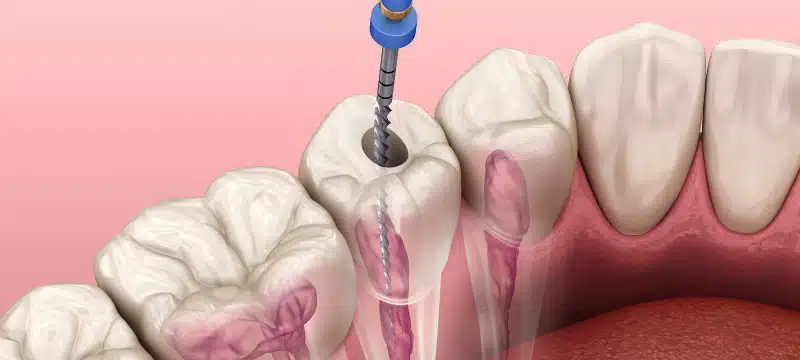
Root canal treatments often come with a lot of apprehensions, primarily due to the fear of pain. However, with advancements in dental technology and techniques, this common dental procedure has become much more comfortable than it once was. Sharq Dental Center aims to demystify the pain associated with root canal treatments and provide practical tips for managing it, particularly in Qatar.
Understanding Root Canal Treatment
A root canal treatment is a specialized dental procedure aimed at rescuing and restoring a tooth that’s significantly damaged or infected. The process involves removing the infected or inflamed pulp, cleaning and disinfecting the inside of the tooth, and then filling and sealing it to prevent further infection.
Understanding the True Nature of Pain in Root Canal Procedures
Most discomfort arises from the infection itself rather than the procedure. With local anesthesia, patients typically experience no more pain than they would during a filling.
What to Expect During the Procedure
During a root canal procedure, you can expect the following steps:
Certainly! Here’s an expanded explanation of each step involved in a root canal procedure:
1. Local Anesthesia:
Before the procedure begins, the dentist will apply a local anesthetic to numb the area around the affected tooth. This is typically done using a small injection. The goal is to ensure you are comfortable and pain-free throughout the procedure. It may take a few minutes for the area to become completely numb. During this time, you might feel a slight pinch or pressure, but it should not be painful.
The anesthesia is a critical step as it makes the entire process virtually painless.
2. Pulp Removal:
Once the area is numb, the dentist will proceed to remove the infected or damaged pulp from inside the tooth. Pulp is the soft tissue inside your tooth that contains nerves, blood vessels, and connective tissue. The dentist will make a small opening in the crown (top) of the tooth to access the pulp chamber. Using specialized dental tools, the dentist will carefully remove the diseased pulp from the chamber and root canals (the pathways inside the tooth).
This step is vital as removing the infected or inflamed pulp alleviates pain and prevents the spread of infection to other parts of your mouth.
3. Cleaning and Sealing:
After the pulp has been removed, the next step involves thoroughly cleaning the inside of the tooth to ensure all the bacteria, debris, and remaining pulp tissue are removed. This is typically done using a series of small files that scrub and clean the walls of the root canals. Once the canals are clean, they will be flushed with a disinfecting solution to kill any lingering bacteria.
After cleaning, the dentist will dry the interior of the tooth and seal it. Sealing is done using a rubber-like material called gutta-percha, which is placed into the root canals to fill them. The top of the tooth is then sealed with a temporary or permanent filling to prevent bacteria from re-entering the tooth. This step is crucial to prevent further infection and ensure the long-term success of the root canal treatment.
Each of these steps is carried out with precision and care to ensure the best possible outcome for the patient, with the aim of saving the tooth and alleviating pain caused by the infection.
Managing Discomfort Post-Procedure
After the procedure, it’s normal to experience some tenderness or mild discomfort for a few days. This can be easily managed with over-the-counter pain relievers. Follow these tips for a smooth recovery:
Take Medication as Advised:
After the root canal procedure, it’s common to experience some discomfort or mild pain as the anesthesia wears off. The dentist may prescribe painkillers or recommend over-the-counter pain relief medications to help manage this discomfort. It is important to follow your dentist’s instructions regarding the dosage and frequency of these medications.
Avoid Chewing on the Affected Side:
After a root canal treatment, the treated tooth and the surrounding area can be tender or sensitive for a few days. To avoid further irritation or damage, it’s advisable to avoid chewing food on the side of your mouth where the root canal was performed.
Maintain Oral Hygiene:
Good oral hygiene is crucial for the healing process following a root canal treatment. It’s important to keep the treated area clean to prevent infection. You should continue to brush and floss your teeth as usual, but be gentle around the treated tooth. Use a soft-bristled toothbrush and brush gently to avoid aggravating the area. When flossing, be careful not to pull or tug too hard near the treated tooth.
Long-Term Care for Your Root Canal
Ensuring the Longevity of Your Treated Tooth
A tooth that has received a root canal treatment has the potential to last as long as your natural teeth, provided it receives the right care and attention. The key to ensuring the longevity of your treated tooth lies in consistent and thorough oral care and regular dental checkups.
Routine Visits to Your Dentist:
After a root canal treatment, it’s important to schedule regular visits to your dentist. These checkups allow your dentist to monitor the treated tooth and surrounding gums and teeth to ensure everything is healing properly and to detect any potential issues early.
Typically, a checkup every six months is recommended, but your dentist might suggest a different frequency based on your individual needs.
Monitoring for Changes:
During these checkups, your dentist will look for signs of any new infection, check the integrity of the crown or filling placed on the tooth, and assess the health of surrounding teeth and gums.
Protecting the Treated Tooth
Avoiding Hard Foods:
Be cautious about chewing hard foods, such as candies, ice, or nuts, with the treated tooth, as these can cause damage to the crown or filling.
Wearing a Mouthguard if Needed:
If you grind your teeth at night, consider using a mouthguard to protect your root canal-treated tooth from excessive pressure and potential fractures.
Conclusion
For residents in Qatar seeking a pain-free root canal experience, your ideal destination is a facility where skilled dental professionals use the latest techniques and equipment to ensure that your root canal procedure is as comfortable and efficient as possible.
In such centers, the priority is on your comfort and dental health, providing you with a worry-free experience and the best possible outcomes for your oral health, much like the care provided at Sharq Dental Center.
